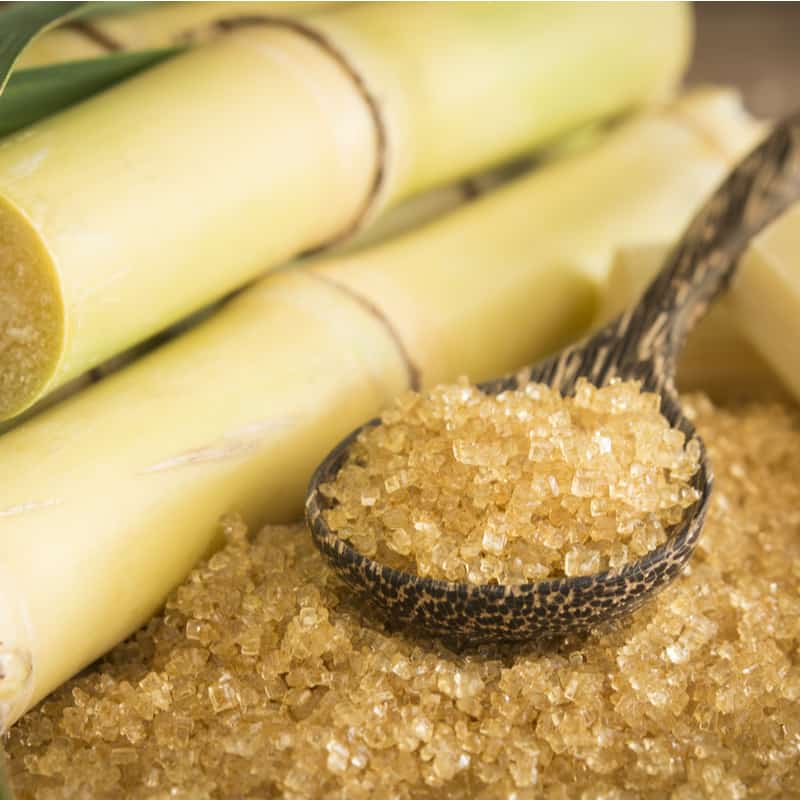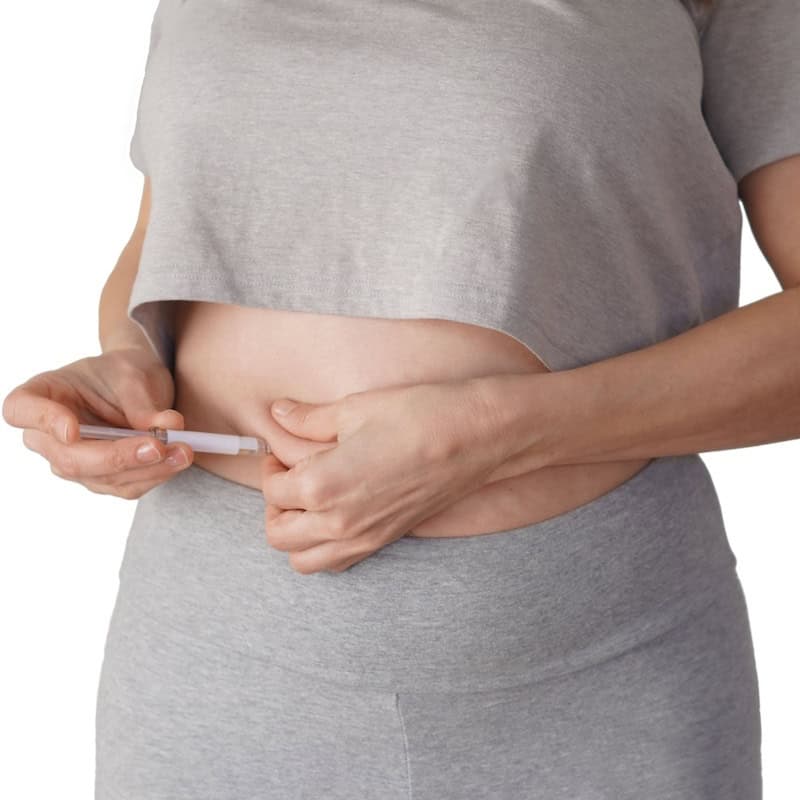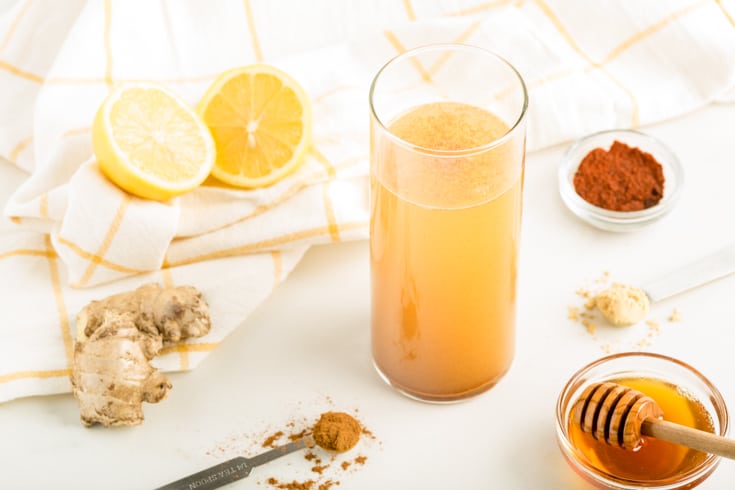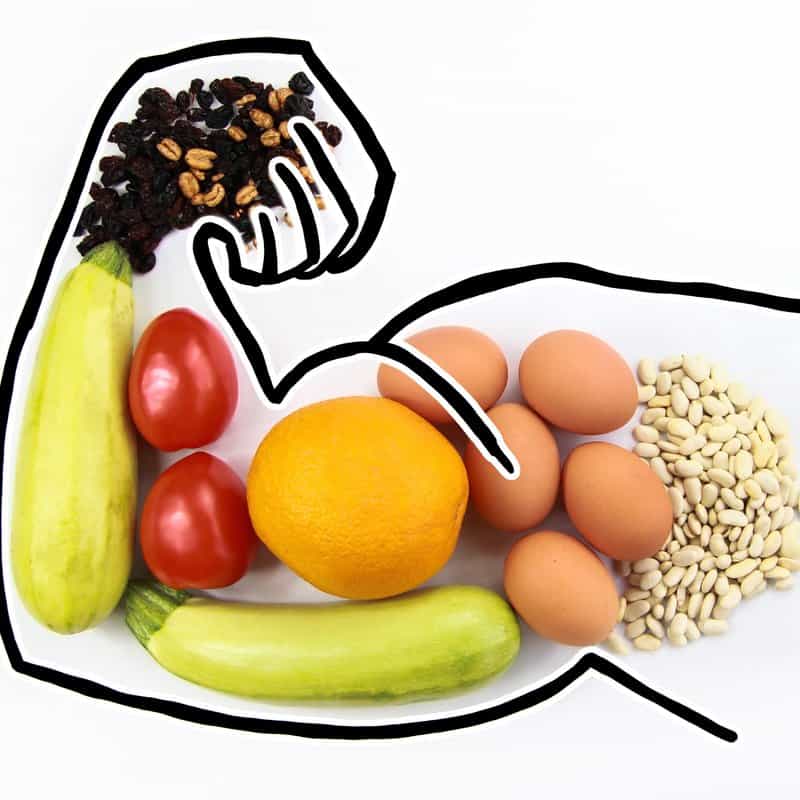This Dr. Axe content is medically reviewed or fact checked to ensure factually accurate information.
With strict editorial sourcing guidelines, we only link to academic research institutions, reputable media sites and, when research is available, medically peer-reviewed studies. Note that the numbers in parentheses (1, 2, etc.) are clickable links to these studies.
The information in our articles is NOT intended to replace a one-on-one relationship with a qualified health care professional and is not intended as medical advice.
This article is based on scientific evidence, written by experts and fact checked by our trained editorial staff. Note that the numbers in parentheses (1, 2, etc.) are clickable links to medically peer-reviewed studies.
Our team includes licensed nutritionists and dietitians, certified health education specialists, as well as certified strength and conditioning specialists, personal trainers and corrective exercise specialists. Our team aims to be not only thorough with its research, but also objective and unbiased.
The information in our articles is NOT intended to replace a one-on-one relationship with a qualified health care professional and is not intended as medical advice.
Fibroadenoma + 15 Keys for Improving Breast Health
October 16, 2017
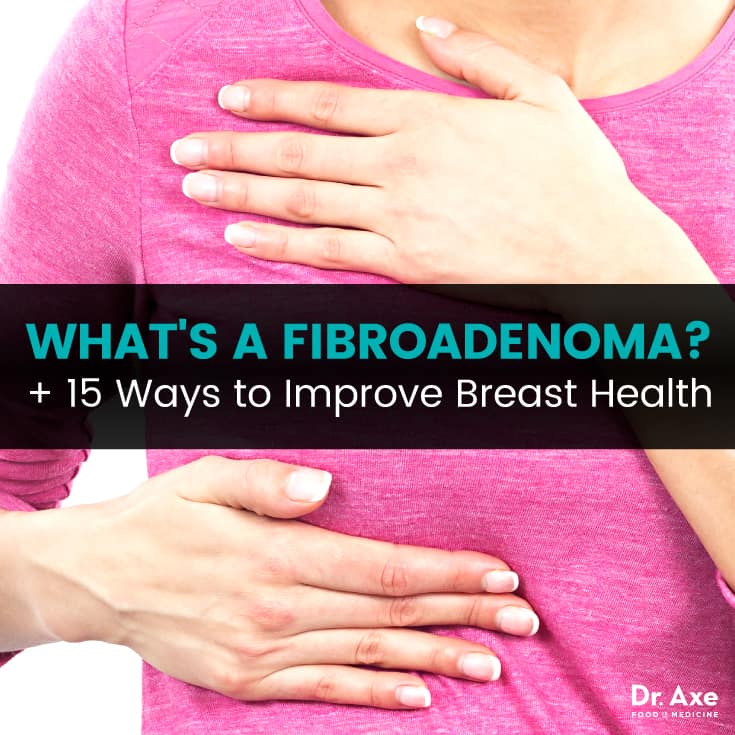
Few things are as frightening for a woman as finding a lump in her breast. While some lumps may be cancerous, many lumps are benign. Noncancerous lumps include fluid-filled cysts, as well as solid lumps called fibroadenomas. A fibroadenoma is among the most common benign lumps that appear in the breast, accounting for 50 percent of all breast biopsies. And, these noncancerous breast lumps are the most common masses found in adolescents. (1, 2)
These lumps typically range from 2 to 3 centimeters in size; however, they can grow to greater than 10 centimeters and cause asymmetry in the breast or even hypertrophy, in some cases. While some women choose to have a lumpectomy for their peace of mind, most fibroadenomas do not require further treatment. But close monitoring is essential to know whether it changes in size or texture. (3)
If you notice changes in an existing lump or find a new lump during your monthly self-examination, schedule an appointment with your physician as quickly as possible. During your appointment, your doctor will explore your family history, perform a clinical breast examination, and then order a mammogram or an ultrasound if you have dense breast tissue. If the imaging tests show that the lump is solid, a biopsy may be necessary to determine the composition of the lump.
These lumps are broken into two categories in the United States: simple and complex. While any changes in the breast naturally cause concern and stress, a breast fibroadenoma only slightly increases your risk of developing breast cancer in the future and this condition should not be considered a cause of cancer. (4)
What Is a Fibroadenoma?
A fibroadenoma is a benign breast mass that often presents during adolescence, but can occur in women at any age. While considered very rare, men, too, can get these benign lumps. This type of mass develops from the glands in the breast, including the lobules and the ducts. Lobules and ducts are surrounded by fibrous, glandular, and fatty tissue. A fibroadenoma occurs when these glandular tissues and ducts grow over a lobule and form a solid lump. (5)
In the United States, two types of fibroadenomas are recognized, simple and complex. Both simple and complex lumps are small in size. They just have different physical characteristics. In other parts of the world, giant and juvenile are also recognized types. (6, 7)
Simple: Generally round, with distinct and smooth borders. If one is close to the surface, it should move easily and may feel rubbery or firm. They rarely cause discomfort or pain; however, monthly hormonal changes and menstruation cycles may cause slight but noticeable changes.
Complex: An irregularity, not size, is what determines if a lump falls into the simple or complex category. According to the Johns Hopkins Avon Foundation Breast Center, one of the following pathological features must be present to make it complex: cystic change, epithelial calcification, sclerosing adenosis, or papillary apocrine hyperplasia. These abnormalities occur in about half of all patients diagnosed with this type of lump. (8, 9)
Juvenile: Occurring in young adolescents and girls aged 10 to 18, a juvenile fibroadenoma can grow quite large, quite quickly. However, most shrink over time and may even disappear. Depending on the size and discomfort it causes, surgical removal may be recommended. Just like adults who find a lump, any changes in the breasts of young girls must be evaluated by a doctor. (10)
Giant: This type grows greater than 5 centimeters causing discomfort, pain or a visible asymmetry in the breast. They may also replace other breast tissue, and your physician may recommend removal of the lump. While this variety of fibroadenoma may be found in women, and even men, they are more common in juvenile girls.
Phyllodes tumors: Some in the medical community classify these tumors alongside fibroadenomas. However, they are different and very rare, accounting for less than 1 percent of all breast tumors. Unlike a fibroadenoma, which typically presents in a smooth, round shape, phyllodes have a more leaf-like pattern. Additionally, unlike their counterparts that develop inside the ducts or lobules, they develop in the breast’s connective tissue. (11, 12)
Phyllodes tumors tend to grow quickly, but they rarely spread beyond the breast. While normally benign, some can be “borderline” or malignant. Often, your medical team will advise their removal, even if they are currently benign. If you find a rapidly growing mass in your breast, it does not automatically mean that it is malignant; some benign masses can grow quickly too. (13, 14)
Signs & Symptoms
A small lump that feels rubbery or like a marble, and moves easily and smoothly under the skin, is often the first sign of a breast fibroadenoma. The edges are well-defined and it rarely causes pain or discomfort. However, some may not be close enough to the surface of the skin to be felt, unless under pressure such as while lying on the stomach or receiving a hug. And, if they are deep in the tissue, they may only be identified through a mammogram or ultrasound.
During pregnancy, women may experience rapid growth of this type of lump. During menopause they often shrink. Just remember, any noticeable changes should be reported to your physician.
Causes & Risk Factors
The exact cause remains unknown; however, there is some evidence that a fibroadenoma may be related to the reproductive hormones estrogen and progesterone. Researchers acknowledge the following as possible causes and risk factors: (15, 16)
- Adolescent girls
- Pregnant women
- Women under 50
- Women on hormone replacement therapies
- Oral contraceptives
- First-degree female relative with breast cancer
- History of benign breast lumps
- History of heavy physical activity in one’s 20s
- Consumption of high-caffeine products like soft drinks, chocolate, tea and coffee may be related, but further research is needed.
- Atypical ductal hyperplasia, a marker that the risk of breast cancer in the future may be elevated.

Conventional Treatments
Before a treatment plan can begin, a proper diagnosis is necessary. This is often the most stressful part of the journey. As the list below indicates, it can sometimes take several visits to your physician and imaging centers over a period of a few weeks or months. Diagnostic tests include: (17, 18, 19)
- Physical, Hands-On Examination. The physician will use their fingers to feel for any lumps or bumps and check for nipple discharge.
- Mammogram. Mammograms are often more emotionally draining than they are physically painful. Essentially, a mammogram is just an X-ray of the breast taken from a variety of angles while the breast is compressed between two plates. A radiologist examines the X-rays looking for any abnormalities. When a density or mass is detected, a diagnostic mammogram may be ordered.
- Diagnostic Mammogram. The same mammography machine is used; however, the radiologist selects specific areas to be examined. In this test, the breast may be compressed more firmly, and additional angles and positions may be required. Again, it is rarely painful, and the discomfort lasts just 10 seconds or so for each position.
- Ultrasound. After a diagnostic mammogram, if the radiologist still questions an area or areas, an ultrasound may be ordered. This is the first step in determining if the density or mass is solid or fluid-filled. The ultrasound cannot detect whether the density is cancerous or not. There is no pain or discomfort typically associated with an ultrasound.
- 3D Mammography. Relatively new to the market, 3D mammography or breast tomosynthesis, permits specific sections of the breast to be viewed more clearly. Often, the doctor will ask the technician for several positions and new views. There is a slight increase in the amount of radiation, which can be a concern for some, but lesions are more visible.
- Fine Needle Biopsy. If the mammogram and ultrasound show a mass, your physician may want to do a fine-needle aspiration. This is typically an in-office procedure where a very fine needle is inserted into the breast and the doctor draws liquid out of the lump. Very little discomfort or pain is associated with this procedure.
- Core Needle Biopsy. Like a fine needle aspiration, a needle is inserted into the lump, but the goal is to remove tissue samples for screening. This requires a larger needle, and the surgeon typically uses an ultrasound to help guide the needle to exactly the right place. This procedure is done under a local anesthetic. Some minor discomfort, including minor pain and bruising, is to be expected.
- Surgical or Open Biopsy. Your medical team may want to remove a part of the lump or the entire lump for testing in the laboratory. This is done in a hospital’s outpatient surgical facility under local anesthesia and, in some cases, under general anesthesia. Swelling and discomfort are to be expected.
Treatment plans vary from person to person, but generally simple lumps do not require further medical intervention. In fact, some lumps may shrink or disappear without treatment. However, additional screenings at six months and 12 months may be advised.
With complex lumps, your doctor may recommend surgical removal for peace of mind and physical comfort. If the lump or lumps are on the larger size and causing pain, surgery can help to relieve it. This is typically done as a lumpectomy or an excisional biopsy, and, in rare cases, as a cryoablation where a gas is used to freeze and destroy the tissue.
If surgical removal is recommended, please understand additional noncancerous lesions and lumps may develop, and the same diagnostic tests listed above may be necessary to rule out cancer.
With juvenile fibroadenoma, observation is generally suggested; however, a core needle biopsy or open biopsy may be recommended. If the lump becomes too large and transitions into the giant category, it may start to cause a deformity in the breast or noticeable asymmetry. In these cases, a complete excision may be the best course of action. (20, 21)
15 Keys for Improving Breast Health with Fibroadenoma
If you’ve been diagnosed with a noncancerous lump, or you have a family history of breast cancer, you may want to consider thermography. This noninvasive screening helps to identify fast-growing and active tumors. It can help your doctor identify subtle changes in your breast. Additional benefits include no additional exposure to radiation, and many insurance companies cover the screening. Even if your insurance doesn’t cover the cost, affordable screenings may be locally available. (22)
Breast cancer is, of course, the greatest fear when a lump is detected in the breast. And for good reason. The statistics are frightening. (23)
- One in 8 women in the United States will develop an invasive breast cancer in their lifetime.
- Over 250,000 new cases are expected to be diagnosed this year.
- Over 40,000 women in the United States are expected to die this year as a result of breast cancer.
- For women in America, breast cancer death rates are higher than any other cancer except lung cancer.
- Eighty-five percent of breast cancers occur in women with no family history
As mentioned above, while researchers aren’t quite sure why a noncancerous fibroadenoma slightly increases the risk of breast cancer, any breast health issue causes a pause, and, naturally, some anxiety. So much research has been done on breast cancer and prevention and much of the evidence circles back to diet and early detection.
1. Eat more fresh fruits and vegetables. A study conducted by the Centers for Disease Control and Prevention (CDC), Fred Hutchinson Cancer Research Center and other highly respected cancer centers across the globe found that an increased consumption of fresh fruits and vegetables, along with moderate exercise, is associated with a decreased risk of breast cancer. The study brought particular attention to the benefits of consuming sesame oil because of the PUFA fatty acids it contains; seaweed; garlic and onions; and lychee fruit. (24)
2. Enjoy organic meats and cultured dairy. In addition to fresh fruits and vegetables, top cancer-fighting foods include organic meats, wild-caught fish, nuts and seeds, mushrooms, tea, and cultured dairy products like kefir and yogurt.
3. Blueberries. A top healthy choice, blueberries contain vitamins C and K, manganese, and fiber, as well as the phytochemicals quercetin, reservatrol and pterostilbene, which have been specifically identified to increase the self-destruction of certain types of cancer cells including lung, stomach, pancreatic, and breast cancer cells. (25)
4. Flaxseeds. A study from the University of Toronto’s Department of Nutritional Sciences found that the lignans in flaxseed are associated with decreased cancer growth and are effective for reducing the risk of breast cancer and to consume in treatment. Purchase a high-quality organic flaxseed and grind into a fine powder. Add to your favorite smoothie, sprinkle on oatmeal, or add to a salad to receive its benefits. (26)
5. Beta-Carotene rich-foods. A study from Germany published in the journal Breast Cancer Research and Treatment found that a diet including beta-carotene foods shows a slight positive effect on breast health, particularly in postmenopausal women. An additional study shows carotenoids reduce oxidative danger and they are particularly helpful in reducing the risk of breast cancer in premenopausal women who smoke. (27, 28)
Add more beta-carotene foods to your diet like carrots, pumpkins, sweet potatoes, winter squash, cantaloupe, apricots and mangos — basically any fruit or vegetable that has a rich orange or yellow hue after you’ve been diagnosed with a noncancerous mass.
6. Green tea. The polyphenolic compound catechin has been shown to improve breast health, density and estrogen levels. Researchers believe this is due to its outstanding antioxidant activities. Enjoy three or four cups of green tea per day for best results. (28)
7. Leafy greens and cruciferous vegetables. A study from researchers at the Slone Epidemiology Center at Boston University on African-American women found that a diet rich with carotenoid vegetables and cruciferous vegetables decreases the risk of breast cancer. (29)
8. Get out in the sunshine. The University of California, San Diego School of Medicine has found that higher levels of vitamin D are associated with a reduced risk of breast cancer, lung cancer and bladder cancer. When possible, try to get 20 minutes each day of unfiltered sun exposure. For those in northern climates, add 10,000 IU of a high-quality vitamin D3 supplement daily. (30)
9. Pomegranate. Studies show that the polyphenols in pomegranate might fight cancer growth, particularly in estrogen-dependent cancers like breast cancer. Researchers indicate that long-term studies are needed and noted that a high-potency botanical supplement was used in their research. If you are on ACE inhibitors, blood pressure medications, statins, or blood thinners, avoid pomegranate supplements. (31)
10. Turmeric. The curcumin in turmeric has been shown to fight certain tumors and demonstrates anti-breast cancer activity. A study published in the journal Current Pharmaceutical Design found that the polyphenolic curcuminoids are responsible for anti-breast cancer activity and that individual curcuminoids inhibit cancer cell growth. For improving breast health, take 2,000 milligrams of turmeric daily; make sure the supplement contains 20 milligrams of piperine to increase bioavailability and absorption. (32)
11. Walnuts. The nut that looks like a brain is rich with healthy omega-3s and has been shown to slow the growth of breast cancer tumors. And, walnuts can reduce cancer growth and development according to researchers. An added benefit is that they support weight loss and are a filling snack, suitable for young children and adolescents. (33)
12. Lion’s Mane Mushroom. Don’t let the scruffy look of the lion’s mane mushroom dissuade you; research indicates it exhibits anticancer activity specifically for the breast and colon. While this exotic mushroom is rarely available in local grocery markets, they can be found in many Asian markets or you can purchase a high-quality supplement. (34)
13. Evening Primrose Oil. According to the Mayo Clinic, there is research that suggests that evening primrose oil may ease menstrual cycle breast pain due to breast cysts. Some researchers believe that women who have a deficiency in linoleic acid may be more sensitive to fluctuations in hormones, and evening primrose may help to alleviate the deficiency. (35)
14. Exercise. Multiple studies show that exercising a minimum of 150 minutes each week can lower the risk of breast cancer and other types of cancer. A French study has found exercise particularly important for postmenopausal women, and researchers stressed that continuing to exercise was the key. Walking, gardening, yoga, tennis and golf are all great moderate activities suitable for any age. (36)
15. Meditation. Seeking a mind-body balance through meditation can be instrumental in relieving the stress and anxiety after a diagnosis. While these lumps are not cancerous, the possibility of cancer in the future weighs heavy on the heart and mind. Studies show that meditation reduces stress in cancer patients and enhances coping mechanisms and well-being. (37)
Precautions
A breast fibroadenoma is not cancerous. However, it does slightly increase your risk of developing breast cancer in the future. Eating a healing diet rich in lean proteins, fruits and vegetables, nuts and berries may help to reduce your overall risk of certain cancers, including breast cancer. Any changes in breast health, including the development of new lumps or changes in existing lumps, need to be evaluated by your health care team.
Final Thoughts
- Breast health is one of the top concerns among women.
- A fibroadenoma is a noncancerous mass believed to be related to hormonal changes.
- Hormone replacement therapies and oral contraceptives may increase the risk of developing this type of breast lump.
- Young girls and adolescents can be afflicted with masses that grow rapidly and become so large that they cause asymmetry or disfigurement.
- Fibroadenoma diagnosis may require multiple tests over a period of weeks, months or years.
- Yoga, exercising and meditation can help relieve the mental and emotional stress associated with the diagnosis period and a confirmed diagnosis.
- Conventional treatment often involves the “wait and see” approach where mammograms and ultrasounds are used every six months to identify any changes.
- Thermography is noninvasive and may help to identify breast cancer and other rapidly growing tumors sooner, without additional exposure to radiation.
- While noncancerous, breast fibroadenomas do slightly increase the risk of developing breast cancer in the future.
- Research from around the globe indicates that a diet rich in fresh fruits and vegetables, lean proteins, berries and nuts, and cultured dairy may help prevent breast cancer.



